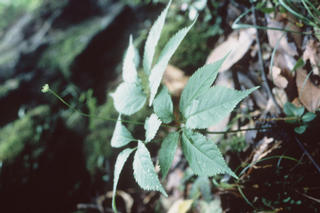Panax japonicum
Contents
Nomenclature
Other Names:
Historical Use of Panax japonicum
Panax japonicum in Traditional Chinese Medicine
Background
Chinese Name (pinyin): Zhujieshen
Chinese Name :
Common Name :Japanese Ginseng
Specific Name : Rhizoma panacis japonici
Scientific Name:
Collection : The drug is collected in autumn, removed from the main root, peeled and dried.
Description : Slightly cylindrical, somewhat curved, some with fleshly laternal roots. 5 - 22 cm long 0.8 - 2.5 cm in diameter. Externally yellow or yellowish brown, tough with dense transverse wrinkles and root scars. Nodes conspicous, internodes 0.8 - 2 cm long, each showing a dented stem scar. Texture hard, fracture yellowish white to pale yellowish brown showing yellow dotted vascular bundles arranged in a ring. Odourless, taste bitterish and then slightly sweet.
Identification : 1.Transverse section: Cork consisting of 2 - 10 layers of cells. Cortex slightly broad, scattered with secretory canals. Vascular bundles collateral in a ring. Cambium in aring. Phloem secretory canals found occasinally. Xylem bundles almost in 2 - 4 strands arranged radially or in a row. Wood fibres usually in 1 - 4 bundles. Some accompanied by larger, lignified scleeerenchymatous cells. Pith visible. Parenchymatous cells containing abundant clusters of calcium oxaxlate 17 - 70 µm in diameter and starch granules.Powder: Yellowish white to yellowish brown. Wood fibres in bundle, about 25 µm in diameter. Walls slightly thickened, pits oblique cleft like, some crisscross to V-shape. Clusters of calcium oxalate numerous, 15 - 70 µm in diameter. Vessels scalariform, reticulate or bordered pitted. 20 - 70 µm in diameter. Resin canal pieces occasionally found containing yellow masses. Cork cells polygonal, rectangular or irregular and walls thickened. Starch granules abundant, mainly simple, subrounded, about 10 µm in diameter or gelatinized.2.Shake 0.5g of the powder with 5 ml of ethanol for 5 minutes and filter. Evaporate the filtrate to dryness. Add dropwise saturate solution of antimony trichloride in chloroform, again evaporate to dryness, a violet red color is produced.3.Mix well 1 g of the powder with 5 - 10 drops of water and 10 ml of n-butanol saturated with water, stopper closely, shake for about 10 minutes, stand overnight, filter. Evaporate the filtrate to dryness, heat the residue under reflux with 10 ml of a mixture of sulfuric acid and 30% ethanol (1Õ20) for 2 hours, extract with chloroform, wash the chloroform solution with 10 ml of water and discard the washing. Evaporate the chloroform solution to dryness. Dissolve the residue in 1 ml of methanol as the test solution. Dissolve oleanolic acid CRS panaxiodol CRS and panaxatriol in methanol to produce three solutions respectively containing 2 mg of olealonic acid and 0.5 mg for other two per ml as the reference solution. Carry out the method for thin layer chromatography (Appendix Vl B), using silica gel G as the coating substance and benzene ethyl acetate (1:1) as the mobile phase. Apply separately to the plate 5 µl of the test solution an1 ml of the reference solutions. After developing and removal of the plate, dry it in the air. Spray with 10% of sulfuric acid solution in ethanol, heat at 105ºC until the spots clear. The spot in the chromatogram obtained with the test solution correspond in position and color to the spot in the chromatogram obtained with the reference solutions.
Processing : Eliminate foreign matter, pound to pieces before use.
Action : To strengthen the constitution, to eliminate blood stasis and relieve pain, to arrest bleeding, and to promote expectoration.
Indication : general weakness after disease; consumptive cough with hemoptysis, cough with profuse sputum; traumatic injuries
Precautions :
Dosage : 6 to 9 g.
Storage : Preserve in a ventilated place, protected from moth.
Synonymns for Panax japonicum
Patent Medicines and Medicines with Multiple Ingredients that include Panax japonicum
Pharmaceutical Information
Chemical Constituents
Evidence or the Use of Panax japonicum in the Treatment of Epilepesy
Basic Science
Animal Studies
Cohort, Case-Control and Non-Randomized Trials
Randomized Controlled Trials
Meta-Analysis
1st Five Results: pubmed search
Hongrui Li, Caiwen Huang, Yanhong Li, Pujing Wang, Jingxian Sun, Zizhen Bi, Shisheng Xia, Yong Xiong, Xishan Bai, Xiangzhong Huang
Ethnobotanical study of medicinal plants used by the Yi people in Mile, Yunnan, China.
J Ethnobiol Ethnomed: 2024, 20(1);22
[PubMed:38395900]
[WorldCat.org]
[DOI]
(I e)
Serafino Teseo, Benjamin Houot, Kaiye Yang, Véronique Monnier, Guangrong Liu, Hervé Tricoire
##Title##
Aging Dis: 2021, 12(2);425-440
[PubMed:33815875]
[WorldCat.org]
[DOI]
(P e)
M Yamazaki, K Hirakura, Y Miyaichi, K Imakura, M Kita, K Chiba, T Mohri
Effect of polyacetylenes on the neurite outgrowth of neuronal culture cells and scopolamine-induced memory impairment in mice.
Biol Pharm Bull: 2001, 24(12);1434-6
[PubMed:11767118]
[WorldCat.org]
[DOI]
(P p)
K Chen, C Li
Recent advances in studies on traditional Chinese anti-aging materia medica.
J Tradit Chin Med: 1993, 13(3);223-6, contd
[PubMed:8246603]
[WorldCat.org]
(P p)
Q Chi, J Guo, Q Dang
[Thin layer chromatography and extractive technology of Panax japonicum C.A. Mey. var. major (Burk.) C. Y. Wu et K. M. Feng growing in Qingba Mountain Area].
Zhongguo Zhong Yao Za Zhi: 1992, 17(8);478-80, 511
[PubMed:1482533]
[WorldCat.org]
(P p)
